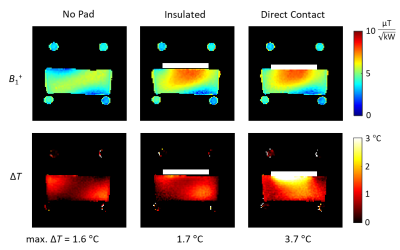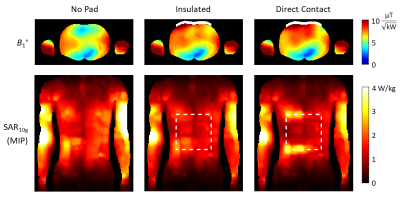Wyger Brink1, Rob Remis2, and Andrew Webb3
1Leiden University Medical Center, Leiden, Netherlands, 2Circuits and Systems, dept. of Microelectronics, Delft University of Technology, Delft, Netherlands, 3C.J. Gorter Center, dept. of Radiology, Leiden University Medical Center, Leiden, Netherlands
1Leiden University Medical Center, Leiden, Netherlands, 2Circuits and Systems, dept. of Microelectronics, Delft University of Technology, Delft, Netherlands, 3C.J. Gorter Center, dept. of Radiology, Leiden University Medical Center, Leiden, Netherlands
In this work we demonstrate the impact of modelling material insulation in between a high permittivity pad and the body, using both RF simulations as well as phantom experiments.

Fig.
2. Phantom measurements without and with the high permittivity pad in place, with
and without insulation. Shown are transverse cross-sections of B1+
efficiency (top) and temperature increases (bottom).
The position of the high permittivity pad is illustrated in white, and the numbers denote the maximum temperature increase.

Fig.
1. Simulated effects of high permittivity material positioned on the anterior
side of the male body model, with and without insulation. Shown are transverse
cross-sections of the B1+ efficiency (top) and coronal maximum intensity projections of SAR10g
(bottom). SAR data were normalized to an average B1+
magnitude of 1 uT within the transverse cross-section of the body model. The
position of the high permittivity material is illustrated in white.
